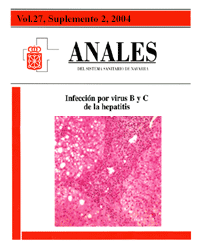Acute hepatitis C virus infection
Keywords:
Hepatitis aguda. Clínica. Diagnóstico. Tratamiento. Interferón.Abstract
Acute hepatitis C virus infection produces clinical and biochemical features that is non-specific and indistinguishable from those caused by other hepatotropic viruses. The specific diagnosis of acute hepatitis C virus infection is based on the detection of serum RNA-HCV through a technique of PCR whose result will be positive after 1-2 weeks of the initial contact with the virus. The anti-bodies against HCV are detected later (after 7-8 weeks on average), and are not useful, as an isolated determination, in distinguishing acute infection from chronic infection or in clearing the virus (spontaneous or following treatment). Fifty-five to eighty-five percent of patients with acute HCV infection do not clear the virus and develop a chronic infection with risk of evolution to cirrhosis and of developing hepatocellular carcinoma. For this reason, the present tendency is to treat with interferon all those patients in whom RNA-HCV remains positive after 3-4 months following diagnosis of acute infection.Downloads
Downloads
Published
How to Cite
Issue
Section
License
La revista Anales del Sistema Sanitario de Navarra es publicada por el Departamento de Salud del Gobierno de Navarra (España), quien conserva los derechos patrimoniales (copyright ) sobre el artículo publicado y favorece y permite la difusión del mismo bajo licencia Creative Commons Reconocimiento-CompartirIgual 4.0 Internacional (CC BY-SA 4.0). Esta licencia permite copiar, usar, difundir, transmitir y exponer públicamente el artículo, siempre que siempre que se cite la autoría y la publicación inicial en Anales del Sistema Sanitario de Navarra, y se distinga la existencia de esta licencia de uso.








